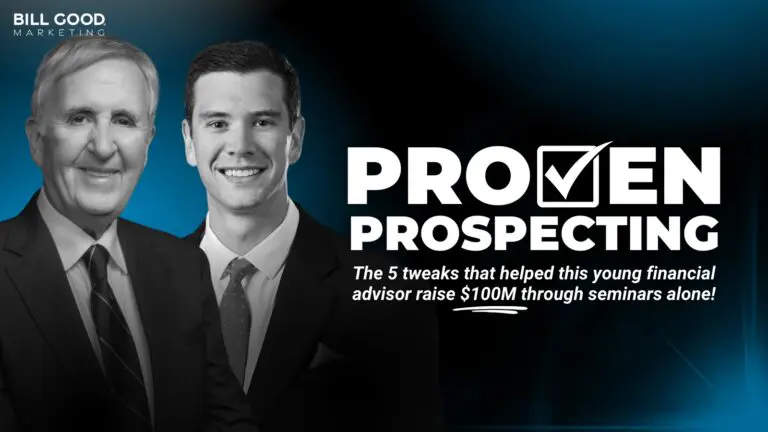
Top 3 Investment Advisor Prospecting Hurdles & Solutions
Presumably, you are reading this article because you’re interested in financial advisor prospecting. So, before we do anything else, let’s define what prospecting actually is.
According to Datareportal, there are now 4.76 billion social media users worldwide. That’s more than half of the world. 59%, if you want to get nerdy.
Social media is a powerful tool for growth. It’s relatively low-cost compared to paid ads — relying more on your consistency instead of your budget.
Having a social media presence helps you build rapport with prospects before they even step in for a discovery meeting.
As long as you’re consistent, keep your goals in mind, and understand how the algorithm works, you can reach enough people to build the client roster you’ll have for your whole career.
Social media can affect your bottom line even if you’re not a big influencer.
If the growth potential in these social networks still isn’t enticing enough for you, here are a couple more reasons why financial advisors use social media to get clients.
Tap into customer and industry insights. By interacting with more of your prospective clients on social media, you get a peek into the concerns they’re struggling with.
While you don’t need to prepare an iconic dance to build your social media presence, there’s some know-how you can implement. Here are some of our best social media tips you can use to kick off your social media marketing plan.
When creating your social media marketing strategy, here’s one thing you need to know: you don’t need to be on every platform to get results.
In fact, starting with more platforms than you can handle leads to burnout. And you can’t afford that — consistency is highly rewarded on most social media platforms.
Picking one or two platforms at first is a better idea if you consider the time and effort it’ll take to grow your social media presence.
There are many different social media platforms available, and it’s important to choose the ones that are most likely to reach your ideal client. A quick study you can do is pick your top five favorite clients and see where they live on social media. That’s your platform.
A few popular social media channels to consider:
Client stories give prospects a glimpse into what it’s like to work with you and what service you can provide.
A word of caution: get your clients’ permission to share their stories, even if it’s anonymously.
In the flotsam of today’s social media marketplace, having a unique voice is crucial for standing out. There are countless distractions vying for your audience’s attention and it is very easy to swipe or scroll on by.
So, use your own voice to differentiate yourself from the sea of corporate-speak that floods the channels of social media.
Create a strong online identity to help you connect with your audience on a more personal level, and which can drive engagement with your content. So, don’t be afraid to be yourself and showcase your unique personality it is the key to building a loyal following and can ultimately help grow your business.
Educational and thought-leadership content helps you establish your brand as an expert in the financial services industry.
When sharing educational content on social media, it’s important to ensure that the information is accurate and well-researched. Also, run that content by your compliance before you post or share it from another account. Nothing will damage your reputation more than bad information.
Again, use your own voice to offer a unique perspective on whatever topic you are sharing.
When you can establish yourself as a thought leader in your field, you claim a position all advisors strive to gain.
You are top-of-mind. And in that position, you are much more able to attract potential clients.
While social media is a great place to share content, the real power of social media is the personal connections you’ll make and manage.
Think of social media platforms as a really big networking event — and all you need to do is find someone and strike up a conversation.
This will look different depending on your goals.
The initial step is to identify the people you want to do business with. Get a picture of your favorite client. What needs does that person have? Who are their friends? What clubs do they belong to? Who is their CPA? Attorney? Tennis Coach? Once you have identified the details of this real client in your life, you have a good blueprint of your ideal client. Start finding and following them on social media.
An important word of advice: Don’t be a creeper and stalk all your client’s friends. We’ll connect you to them in another way.
No one wants to read a long, drawn-out post about anything, let alone your latest tip on setting up 529s. They want quick content that they can consume and move on. But before you post anything, make certain you know your audience.
Maybe you are targeting parents, in which case a series of tips on 529s would be totally appropriate. Use awesome graphics, photos, and videos. If you don’t have something that snags attention, you will be lost in the blur as your prospects fly right by.
Focus on posting feel-good content that is local to your community. And avoid controversial, or highly charged emotional topics.
When trying to attract potential clients on social media, it’s important to track engagement to see what content resonates with your audience.
Use built-in engagement metrics to check your content. Or better yet, go the extra mile and install social analytics apps like Shield.
There are platforms, such as YouTube, that give you tracking capabilities so you can see the demographics you attract. Save yourself some time by understanding who your audience is and what they watch. Then refine what content you create to satisfy that target audience.
Use social media posts to share links from your website and study which ones get engagement. This is what people are interested in. Do more of that until your engagement levels drop. Then offer links to more content and re-discover what your audience is interested in. Then wash, rinse, repeat. As you grow your audience, you will also attract more potential clients to your services.
If you’re also creating bigger pieces of content like blog posts, podcasts, or YouTube videos, tracking your engagement can be a great way to test if your audience prefers a certain topic.
By tracking engagement, financial advisors can fine-tune their social media strategy and attract more potential clients.
The financial industry is constantly changing, so it’s important for financial advisors to stay up-to-date with industry news.
While there are a lot of ways to do this, social media gives you a place to also share your thoughts on recent developments. This gives your potential clients an insight into your thought process and approach to financial planning.
For example, browse through common industry hashtags to find similar social media accounts as yours and see what they’re doing with their online presence.
One of the main benefits of staying up-to-date with industry news is that it can help you learn about changes that may impact your prospect’s businesses — and guide them through it.
If you have a team member who lives and breathes social media, delegate this marketing strategy to them.
If you don’t, then outsource it to a pro.
A professional is familiar with the algorithm. They have proven tactics to grow your social media presence. And they know the ins and outs of social media, so they can create content quickly, interact with potential clients, and provide valuable insights on how to reach your target audience. Most importantly, they know how to measure the results that align with your goals and refine your campaigns accordingly.
With decades of experience helping financial advisors grow, Bill Good Marketing can help you create your own growth machine.
Get the best practices we use to consistently generate qualified leads, strategies to remove your business roadblocks, and a CRM that supports both your digital marketing and offline efforts.
Call 866-353-7859 to find out how we can help you reach your goals.


Andrew is a digital marketing expert here at Bill Good Marketing. Before joining Bill Good Marketing, Andrew spent most of his previous work experience in the digital marketing realm helping small businesses with things such as Web Design, SEO, and Social Media Management.

Presumably, you are reading this article because you’re interested in financial advisor prospecting. So, before we do anything else, let’s define what prospecting actually is.


Cold-calling is NOT a “try it once and hope it works” endeavor. It requires testing and tweaking to learn what works for your market, your list, and for you. Cold-calling is NOT for advisors who fear rejection. You will get a lot of rejections when you cold call – but if you follow best practices, it won’t matter, because the number of new leads you…


Staying on top of the best keywords for your business is essential for effective SEO. As we’ve discussed, these keywords help connect your website with the people who are searching for the services you offer. Based on insights from Google’s Keyword Planner, here are the 46 most relevant keywords for financial advisors…


When Neil McPeak Jr. — CFP®, CEPA® — joined his father’s practice fresh out of college, he was given one instruction: Learn to prospect. In other words, want to manage your own assets? Go out and find them yourself. (That wasn’t on his college curriculum…


HNW clients. You want ‘em. Everyone wants them. And you’ve likely gotten a dozen emails this month alone on how easy it can be to get more. But whether you’ve been in this industry for 1 year or 30, you know the truth…


Are you ready to unlock the formula that skyrocketed a Texas advisor’s AUM by 900%? Join us for an exclusive, one-time webinar revealing the strategies Mark Trice used to transform his $14M practice into a $134.4M business…